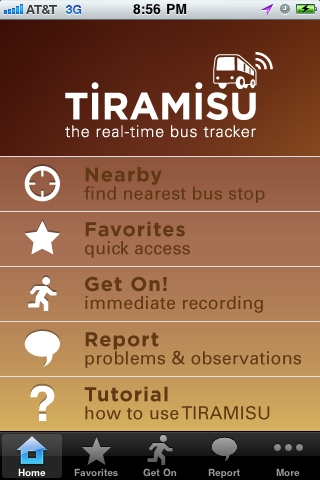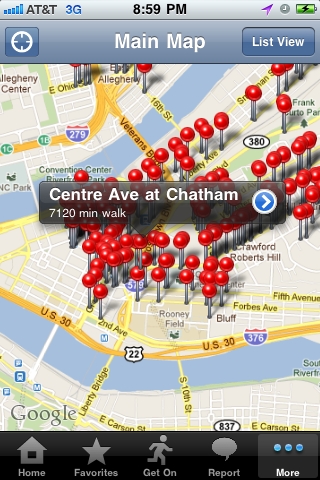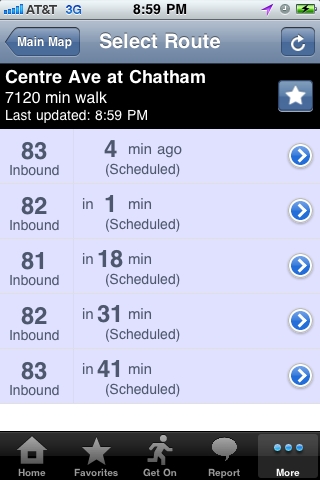Crowdsourcing Realtime Transit Updates

Real-time data crowdsourced from transit riders will improve information sharing for Pittsburgh's public transport. Photo by Amphis d'@illeurs.
Researchers at Carnegie Mellon University released a new smartphone application that will help transit users create a database of real-time information of their local transit agencies.
Cities and transit agencies around the world are making riding easier for their customers by offering real-time arrival data not only at stations and stops but also online to be accessed from anywhere. Unfortunately, many of these systems require hardware to be installed in every vehicle and run on expensive, proprietary software that cash-strapped agencies are often unable to afford.
Additionally, the level of information available in these systems is limited generally to arrival time estimates, which can be of limited use to riders with disabilities. For these passengers, information about the space available on a vehicle is of paramount importance.
Researchers at the Rehabilitation Engineering Research Center on Accessible Public Transportation, a part of CMU's School of Computer Science, recognized these problems. They decided to tackle them head on.
The idea is simple: many transit agencies can't afford to install proprietary Automatic Vehicle Location (AVL) systems in their entire fleet. Yet, with the proliferation of GPS-enabled mobile devices, many transit vehicles already have a latent ability to be tracked.
The CMU team took this to heart and came up with a solution. The result is a program called Tiramisu, available on a mobile website or to any iPhone users in the app store application. Tiramisu uses crowdsourcing methods to gather and supply transit riders with real-time information.
STRAIGHT TO YOUR PHONE
When the app is started, it shows users a list of the nearest bus stops, each of which will display the next bus arrivals, either estimated based on GPS data or given based on the Port Authority schedule.
Tiramisu, which in Italian means "pick me up," relies on users to check in on bus routes, after which the program will use the GPS locator in users' mobile devices to track the location of buses. The system then estimates arrival times at other stops along the route. These real-time arrival estimates are then available to other Tiramisu users on the web or the mobile app.
Users are also encouraged at "check-in" to report on the fullness of the bus, which can be especially helpful to people using mobility devices who need a little extra space to use wheelchair securement spaces. The simple interface allows users to choose one of four fullness levels (many seats, few seats, no seats, full.)
Of course, many crowdsourcing applications face challenges because they rely on continued participation of users. Often, as with a lot of open source software, this participation is mostly out a sense of altruism and community ownership in those users.
Tiramisu may not face quite the same challenge because users' participation in the data collection will directly benefit them on future trips, much more concretely than other crowdsourcing efforts might. Still, the CMU team is experimenting with several motivation models to sustain participation.
GETTING THE WORD OUT
"Our press event was focused on the local Pittsburgh area and the story was covered by newspapers, TV, radio and local web outlets. This led to a surge in users," explained Andrew Steinfeld, senior systems scientist in robotics at CMU. "We are hoping enough of them see the value in the system to keep participating."
Even with excellent participation levels, it's unreasonable to expect a Tiramisu user to be on every bus all the time. So the designers built in several back-up measures. The server collects and uses historic data for each route to estimate arrival times for buses on which there are no users. If historic data is insufficient for estimates, the system will default to the schedule time. At the very worst, users are left with no more information than they would otherwise have had. And that's assuming every bus stop has a schedule posted on it!
As Steinfeld explained in an interview with TheCityFix:
"Accuracy is kind of a complicated answer. We treat each route-time combination as a trip (e.g., the 4:50 p.m. outbound 61C). The historical prediction for a trip will get better the more that trip is recorded. The real-time data will work with just one rider. When we don't have a rider recording in real-time or enough historical data to give a confident estimate, we fall back to the scheduled data."
NEED-TO-KNOW
What is particularly intriguing about Tiramisu is the commitment to universal design that the CMU team held throughout the building process. Not only does the program strive to provide helpful information to riders with disabilities, it is also fully compatible with screen readers and other accessibility software.
The program itself also helps underscore accessibility of transit, allowing users to easily report issues, such as inaccessible bus stops, broken wheelchair securements or even more general problems about a bus, route or driver. This can not only help transit agencies see issues out in the field that might otherwise take expensive surveys and field studies, but it can also give riders a feeling of more direct contact with the agency.
In this respect, it also goes a step further than most real-time arrival apps currently available by combining real-time data with customer feedback mechanisms. And in many respects, the presence of real people checking in on buses can eliminate a lot of the angst that comes from the "ghost bus" phenomenon that crops up from time to time in proprietary AVL systems.
"At the most basic level, we hope it will provide useful information to transit riders of all abilities which is currently unobtainable," Steinfeld said. "We see Tiramisu as a testbed for research on how crowdsourcing can lead to a higher quality of life. Tiramisu is an example of how universal design principles can help transit riders of all abilities share and get the information they need."
Initial beta testing with a small group of riders in Pittsburgh has been promising and now the team will be pushing the program out to the entire riding public. Tiramisu will only be available for riders in Pittsburgh initially, but the creators hope to expand it soon.
Do you live in Pittsburgh, have you used Tiramisu yet?



